Army Soldiers Slash Time To Move From Port To Front: Deterring Russia
Posted on
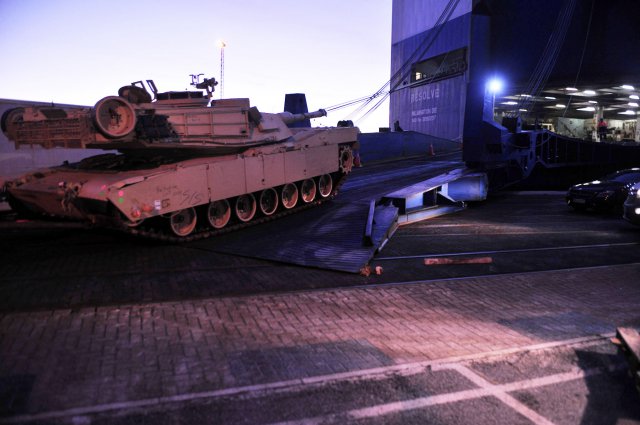
An M1 tank of 3rd Armored Brigade Combat Team, 4th Infantry Division, unloads in Bremerhaven, Germany in January.
HUNTSVILLE, ALA.: Determined to deter the rising Russian threat, the US Army is slashing the time it takes for a brigade to get ready for battle once it’s arrived in Europe, from over 40 days to under 10. Normally unloading equipment, getting organized, and moving to the front takes more than 40 days, Maj. Gen. Duane Gamble told reporters at the Association of the US Army conference here. But thanks to meticulous planning and frantic execution — “it was a dead sprint the whole way” — in January, Gamble’s 21st Theater Sustainment Command helped an armored brigade do it in 14. They aim to do the next in nine.

Maj. Gen. Duane Gamble
That’s a dramatic improvement in a difficult feat. Imagine how hard it is to take your entire family on a road trip, only there are 4,000 of you, you’re driving tanks, and your luggage is full of explosives. But it’s important to put this acceleration in the larger, alarming strategic context:
- First, the 9-14 days of what’s called Reception, Staging, Onward Movement, & Integration (RSOI) doesn’t include the time to sail equipment across the Atlantic. That’s why the service has warehoused a brigade’s worth of equipment in Army Prepositioned Stockpiles, building up to a division by 2021: With the heavy equipment already stockpiled in Europe, you can just fly troops in from the US overnight and start nine days of RSOI.
- Second, these timelines account for the normal friction and mishaps of a major logistical operation, but not for enemy action. Once the shooting starts, “we’re should know we’re going to lose ships,” said Maj. Gen. Flem Walker, deputy chief of staff for logistics at Forces Command, “we’re going to lose brigade combat teams that are afloat on those ships.” On arrival in Europe, the Russians could interfere with ports, railroads, and highways using everything from cyber attacks on critical infrastructure to dock strikes by subverted labor groups to precision strikes by cruise missiles. Traditional deployment timelines create easy targets, Gamble warned: “If you want to put stuff on the pier at Bremerhaven and make it vulnerable to an attack, put it there, let it sit there for 30 days.” That’s another reason to go faster.
- Third, however fast we deploy, the Russians can always deploy faster. In 2016, RAND did a series of wargames exploring a Russian invasion of the Baltic States, and once the Red Army started rolling, these tiny nations’ independence was measured in hours. “Across multiple games,” RAND scholars wrote, “the longest it has taken Russian forces to reach the outskirts of the Estonian and/or Latvian capitals of Tallinn and Riga, respectively, is 60 hours.” It’s a widely shared conclusion.
So trying to race the Russians to Riga from a standing start is, well, a non-starter. Instead, the Army is keeping three brigades in Europe at all times: a light paratroop brigade (the 173rd Airborne) in Italy, a medium Stryker brigade (2nd cavalry) in Germany, and a heavy tank brigade deployed from the US. (Each armored brigade stays nine months, replacing its predecessor “heel to toe” without a gap). Then, if diplomats and intelligence officers picked up “indications and warnings” that Russia was readying an attack, more brigades would deploy from the US — the first wave flying in its troops and picking up equipment from Army Prepositioned Stocks, the second sailing its equipment from the US.
“Given a week’s notice, maybe it’s not fast enough; but given two weeks’ notice, we can do it: We can get the equipment in there and get the soldiers ready to fight” Gamble said. “It’s all about indicators and warnings.”
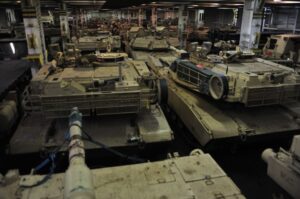
M1 tanks of 3rd Armored Brigade Combat Team, 4th Infantry Division, await unloading in Bremerhaven, Germany in January.
Ultimately, said Gamble, the full war plan’s Time Phased Force Deployment Data (TPFDD) would deploy, not just brigades, but “bring corps and divisions worth of forces back to Europe to counter Russian aggression.” The goal is to build up combat power as fast as possible before the Russians cross the border, in the best case to deter them from attacking altogether and in the worst case to be better able to fight them.
“Our focus today is to build readiness in order to deter aggression, and right now quite candidly we are deterring Russian aggression,” Gamble said. In 2015-2016, he said, the focus was on “assuring allies” by putting US forces in Eastern Europe as tangible proof of American commitment. In 2017, however, he said, the focus is deterring Russia, which requires not just symbolic presence but enough mass to change their war planners’ minds.
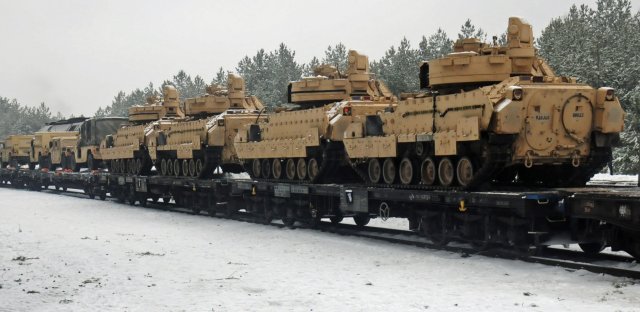
M2 Bradleys of 3rd Armored BCT, 4th Infantry Division on a rail car in Poland.
Fixing Bad Habits
So how do you mass forces faster? To start with, before you can deal with cyber attacks or cruise missiles, you have to get back to basics. Since 2004, Army forces got used to deploying on predictable schedules to well-established infrastructure in Afghanistan and Iraq, typically picking up heavy equipment on arrival from the prior unit rather than having to transport and unpack it.
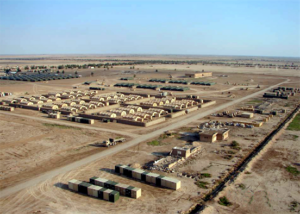
Forward Operating Base (FOB) Hammer, typical of the extensive infrastructure set up in Iraq.
“We picked up a lot of bad habits over the years by not deploying lock stock and barrel,” Walker said. Deploying complete brigades to Europe, bringing their own equipment, “really has shown us we’re very rusty in some of our core sustainment competencies…We have junior leaders and soldiers out there that don’t understand unit movement.”
“There is no Army standard for this,” Gamble said. “We asked (around), ‘what’s kind of the norm?’ The norm is upwards of 30 days for the movement, not to include the integration piece. (What) we practice at the National Training Center is 10 days of just integration.”
Gamble and his staff worked out how to get those 10 days of integration — i.e. getting everyone organized and in position once the equipment is on hand — to four. They also worked how to cuts the 30-plus days of movement — from the first ship pulling into port to the last vehicle arriving at the staging area in Poland to 10. That’s how they got to the 14-day target for the 3rd Armored Brigade Combat Team (ABCT) of the 4th Infantry Division.
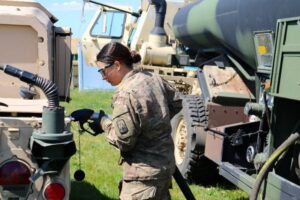
A female sergeant of the 21st Theater Support Command refuels trucks during an exercise in Poland.
“We set a goal for 14 days for the entire brigade to be ready to fight on 20 January, and it was ready to fight on 20 January,” Gamble said proudly. “It was everything, all of the processes from ramp down on the boat, until they were literally ready to be committed into a fight. So the vehicles were fueled, they were camouflaged, they had all the ammo uploaded; the soldiers had been briefed, they had done a couple rehearsals, they’d shot all their tanks on training ranges, shot all their artillery, to make sure that when the round went out of the tube it landed where it was supposed to. (They’d loaded) their radios with secure COMSEC keys, making sure the digits all line up in a Communications Exercise…All of that got done in a 14 day window and it was a dead sprint the whole way.”
One secret to the Army’s success: a strict division of labor between the logistics support units permanently in Europe, the deploying brigade, and the host nations. It’s mainly theater-based logistics troops that handle the unloading of the brigade’s equipment at the port or from the APS warehouses, for instance. “We’ll never build the competency for US CONUS-based soldiers to load rail at the speed and precision we need,” Gamble said, because they’re not doing it all the time like his Europe-based support troops. Most of the brigade’s personnel “overflew” the port and headed straight for the staging areas in Poland, where they got their equipment off the train.
Between port and front, however, there not only logistical but legal hurdles. In peacetime, you need specific permits for each major item of military equipment you bring across an international border. (Those restrictions will probably get lifted when the shooting starts, said Gamble, but by then it’s too late to deter). Poland has gotten its permitting process down from 30 days to 10, Germany down to five, said Gamble, but bureaucracy can only go so fast.
So, rather than spend weeks hanging around the port waiting for clearance, the Army and allies worked to clear everything in advance, which required meticulous advance planning. Soldiers preparing, say, tanks for transit back in the United States had to know exactly which staging area in Poland that tank was going to, on what train, through what border crossing, at what time, then label each vehicle accordingly.
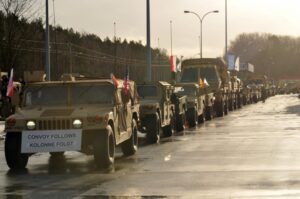
3rd Armored BCT vehicle convoy just after crossing the border in Poland.
Most heavy equipment went by train during the January deployment. Rail transport is much simpler to organize than Army soldiers driving convoy after convoy across Europe, but the rail system has bottlenecks. Most importantly, while there’s a railroad siding at the pier in Bremerhaven where the brigade’s gear came in, it can only load about 1.5 cars at a time; Gamble’s staff found an additional site that could load 2.0 trains at a time, more than doubling throughput. (Again, in wartime, civilian traffic would shrivel up and give the military control of the port, but by that point it’s too late for deterrence). But there will never be as many ways to get somewhere by rail as by road.
So for the next brigade deployment, in September, Gamble plans to rely heavily on truck convoys. The 3rd ABCT sent “a little less than 50 vehicles” by road, Gamble said. “In September, we’ll convoy 400 vehicles through Germany into Poland.” Meanwhile the number of trains will go down from 37 to 20-odd. 400 road vehicles is a lot more moving pieces to plan around, get permits for, and supervise than 37 trains, but it should be faster — fast enough, Gamble said, to get the brigade’s port-to-front time down from 14 days to nine.
Let’s hope the Russians are watching closely, stopwatches and war plans in hand.
Subscribe to our newsletter
Promotions, new products and sales. Directly to your inbox.
